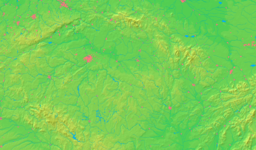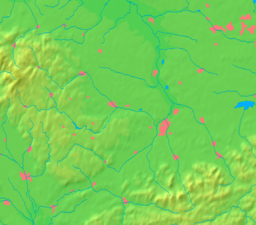- Opava
-
This article is about the city in the Czech Republic. For other uses, see Opava (disambiguation)
Opava Town FlagCoat-of-armsCountry Czech Republic Region Moravian-Silesian District Opava River Opava Elevation 257 m (843 ft) Coordinates 49°56′N 17°54′E / 49.933°N 17.9°E Area 90.61 km2 (34.98 sq mi) Population 60,199 (2008) Density 664 / km2 (1,720 / sq mi) First mentioned 1195 Mayor Zdeněk Jirásek Postal code 746 01 Wikimedia Commons: Opava Website: www.opava-city.cz Opava (Czech pronunciation: [ˈopava] (
 listen); German: Troppau, Polish: Opawa, Latin: Oppavia) is a city in the northern Czech Republic on the river Opava, located to the north-west of Ostrava. The historical capital of Czech Silesia, Opava is now in the Moravian-Silesian Region and has a population of 59,843 as of January 1, 2005.
listen); German: Troppau, Polish: Opawa, Latin: Oppavia) is a city in the northern Czech Republic on the river Opava, located to the north-west of Ostrava. The historical capital of Czech Silesia, Opava is now in the Moravian-Silesian Region and has a population of 59,843 as of January 1, 2005.Contents
Geography
Opava is located on the Opava Hilly Land (Czech: Opavská pahorkatina; a part of the Silesian Lowlands) on the Opava River (left tributary of the Oder River) and Moravice River (right tributary of the Opava River).
History
Opava was first documented in 1195. It received Magdeburg city rights in 1224 and was the capital of the Silesian, Bohemian and finally Austrian Duchy of Opava.
In 1614 Karl I of Liechtenstein became Duke of Opava. After the majority of Silesia was annexed by the Kingdom of Prussia during the War of the Austrian Succession after 1740, the remaining Silesian territory still under the control of the Habsburg Monarchy became known as Austrian Silesia with its capital in Troppau (1742–1918). The Congress of Troppau took place here in 1820.
According to the Austrian census of 1910 the town had 30,762 inhabitants, 29,587 of whom had permanent residence there. Census asked people for their native language, 27,240 (92%) were German-speaking, 2,039 (6.9%) were Czech-speaking and 274 (0.9%) were Polish-speaking. Jews were not allowed to declare Yiddish, most of them thus declared the German language as their native. Most populous religious groups were Roman Catholics with 28,379 (92.2%), followed by Protestants with 1,155 (3.7%) and the Jews with 1,112 (3.6%).[1]
After the defeat of Austria-Hungary in World War I, Troppau became part of Czechoslovakia in 1919 as Opava.
From 1938–45 Opava was part of Nazi Germany according to the Munich agreement. Already a day before Germany's annexation of the Sudetenland in 1938, the town seceded from its okres and became its own Stadtkreis. After the end of World War II, the German population of Opava was expelled in 1945–46 under terms included in the Beneš decrees; many of them settled in Bamberg, Germany.
While the Duchy of Opava has ceased to exist, the title of Duke of Troppau lives on to present day, with Hans-Adam II, Prince of Liechtenstein being the current incumbent.
Economy and culture
Opava is currently an important business and cultural center. It is the location of several economic and cultural institutions serving the entire region, including the Silesian Land's Museum, the oldest Museum in Czech Republic,[2] the Silesian University of Opava, and the Silesian Institute of the Academy of Science. The city is part of a congested industrial area along with Ostrava and produces mining equipment. Opava also awards its own Cultural Prize.
The Silesian Theatre in Opava was founded in the year 1805. Plays were performed in German until the end of the Second World War.
Notable residents
- Joy Adamson, naturalist
- Franz Bardon, magician
- Petr Bezruč, poet
- Eduard von Böhm-Ermolli, Austrian field marshal
- Gerhard Gerlich, politician
- Pavel Hodula, pipe maker
- Martin of Opava, 13th century historian and cleric
- Joseph Maria Olbrich, architect
- Zuzana Ondrášková, tennis player
- Johann Palisa, astronomer
- Boris Rösner, actor
- Bohdan Sláma, film director
- Pavel Složil, tennis player
- Lukáš Vondráček, pianist
- Lucie Weidt, singer
- Rochus Schüch, mineralogist, naturalist
- Josef Gebauer, historian and archivist
International relations
See also: List of twin towns and sister cities in the Czech RepublicTwin towns — Sister cities
Opava is twinned with:
References
- ^ Ludwig Patryn (ed): Die Ergebnisse der Volkszählung vom 31. Dezember 1910 in Schlesien, Troppau 1912.
- ^ About Silesian Land's Museum (in czech) – "Slezské zemské muzeum je nejstarší muzeum v České republice. Bylo založeno v Opavě 1. května 1814." → "Silesian Land's Museum is the oldest museum in the Czech Republic. It was founded in Opava 1st May 1814."
External links
- Official website
- Up-to-date news
- Opavsko24.cz - Regionální internetové noviny pro Opavu a okolí
- staraopava.cz Old postcards (Czech language)
- Opava International Organ Competition
Towns, market town and villages of Opava District Bělá • Bohuslavice • Bolatice • Branka u Opavy • Bratříkovice • Brumovice • Březová • Budišov nad Budišovkou • Budišovice • Čermná ve Slezsku • Darkovice • Děhylov • Dobroslavice • Dolní Benešov • Dolní Životice • Háj ve Slezsku • Hať • Hlavnice • Hlubočec • Hlučín • Hněvošice • Holasovice • Hrabyně • Hradec nad Moravicí • Chlebičov • Chuchelná • Chvalíkovice • Jakartovice • Jezdkovice • Kobeřice • Kozmice • Kravaře • Kružberk • Kyjovice • Lhotka u Litultovic • Litultovice • Ludgeřovice • Markvartovice • Melč • Mikolajice • Mladecko • Mokré Lazce • Moravice • Neplachovice • Nové Lublice • Nové Sedlice • Oldřišov • Opava • Otice • Píšť • Pustá Polom • Radkov • Raduň • Rohov • Skřipov • Slavkov • Služovice • Sosnová • Staré Těchanovice • Stěbořice • Strahovice • Sudice • Svatoňovice • Šilheřovice • Štáblovice • Štěpánkovice • Štítina • Těškovice • Třebom • Uhlířov • Velké Heraltice • Velké Hoštice • Větřkovice • Vítkov • Vršovice • Vřesina • ZávadaCategories:- Cities in Silesia
- Cities and towns in the Czech Republic
- Opava
Wikimedia Foundation. 2010.








